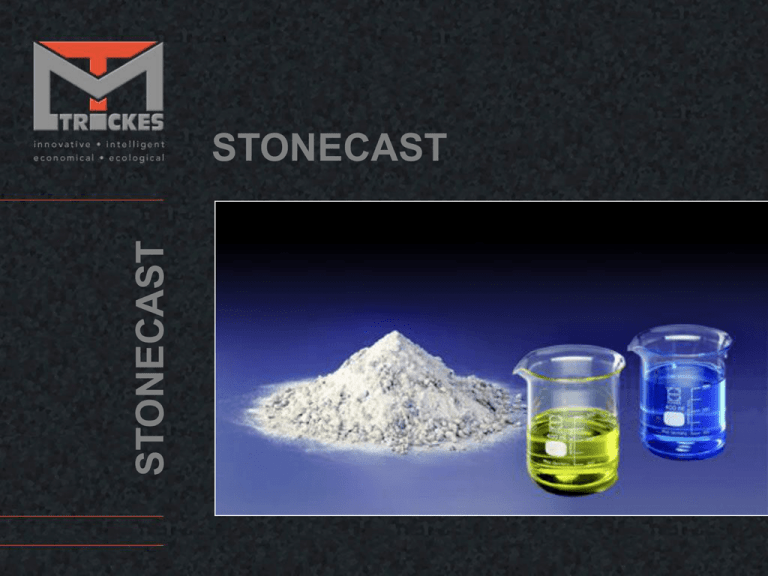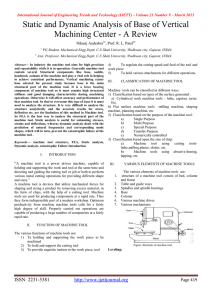Why stonecast? - Trickes Mineralguss
advertisement

STONECAST STONECAST What is stonecast? Stonecast is material made from mineral fillers, quartz gravel, sand, STONECAST stone flour and a small percent epoxy-binder. All those ingredients get mixed into a homogeneous mass which then gets filled into a mould made of wood, steel or plastic. During the filling process the mould gets vibrated in order to condense and de-aerate the mixture. After a few hours the part is ready to be demoulded. Depending on the degree of accuracy demanded the part is ready for mounting. Why stonecast? Higher Damping STONECAST In mineral cast the reduction of vibrations is 6 times faster than in GG-25 and approximately 8-10 times faster than in steel. Higher Damping in Stonecast Damping in grey cast iron Why stonecast? Higher accuracy of the unmachined part mounting casting comparison to the classic process. Classical steps mounting One step Stonecast production casting STONECAST Stonecast parts are poured mostly ready for assembling in Why stonecast? Heat stability STONECAST Less thermal conductance and high thermal capacity lead to a high heat stability, which metallic parts cannot reach. Classic cast Stonecast Why stonecast? Higher finishing accuracy STONECAST Higher production level due to casted in inserts, steel gibs and pipes, etc. Why stonecast? Low costs STONECAST If the material is used according to its possibilities, there is • fewer machining, due to a higher accuracy of the blank • fewer assembly costs • fewer logistic costs, due to less single parts and machining operations Why stonecast? Quickly available STONECAST Mineral cast parts are faster available than iron cast or steel parts, because of the single-step production process. Why stonecast? Ecological view STONECAST Less power is necessary for the manufacturing of a mineral cast part than for iron cast or steel parts. Optimal efficiency of the natural resources, i.e. one kilogramme raw material forms one kilogramme machine part and there is no emission similar to the manufacturing of iron or steel cast. Mineral cast can be recycled. Why stonecast? Stonecast is recyclable STONECAST Stonecast can be dumped on the wast dump, but becomes usually disposed like construction waste, i. e. the parts get crushed and are used as high quality road material. Why stonecast? Stonecast in comparision STONECAST Stonecast in comparison with cast iron and steel characteristic characteristic values unit stone cast cast iron steel density kg/ dm3 2,3 7,15 7,85 E-Modul kN/mm3 30 - 40 80 - 140 210 tensile strength N/mm2 10 - 15 150 - 400 400 - 1600 compressive strength N/mm2 110 - 125 600 - 1000 250 - 1200 bending strength N/mm2 25 - 35 250 - 490 - 0,02 - 0,03 0,003 0,002 damping (log. dekrement) thermal conductivity W/Kºm 1,3 - 2 50 50 spezific effective heat capacity KJ/kgºK 1 0,5 0,5 14 - 16 11 12 thermic co-efficient of expansion SOLUTIONS Body for balancing machine 400kg SOLUTIONS Bed for machining center 3500kg SOLUTIONS Bed for milling machine 2800kg SOLUTIONS Bed for assembling system 1500kg SOLUTIONS Bed for milling Center 4300kg SOLUTIONS Machined, pre-mounted structure for wire erosion machines 1000kg SOLUTIONS Bed for tool grinding machine ready for assembly 2600kg SOLUTIONS Bed for tool grinding machine 2800kg SOLUTIONS Bed for tool grinding machine 600kg Advice We will gladly give you advise regarding the application for stonecast. EFFORTS We help you with the decision and take care that the material will increase your success. Use our 20-years of experience in development and production to get the results you need. Construction We support you constructing the stonecast parts. We get you all the EFFORTS information you need to be able to handle the material. We award youif you wish – with the complete construction created on progressive CAD systems. Mould making Together with competent partners we are able to perform different types EFFORTS of moulds equivalent to the demanded accuracy and number of pieces. Forms made off: • steel • aluminum • wood • plastic or other compositions Production We are equipped with a production area of over 3000 qm and a crane EFFORTS capacity of 15 tons maximum. the material gets processed in a automatic mixing machine, whereby the variance comparison of the components of each load is logged related to each poured section. In the case of deviations the system switches off automatically. The silo system has a capacity of 200t. The production program covers sections with piece weights of 200 - 7000 kg, with a maximum size of 2500 x 4000 mm, with daily casting. Mould / processing Moulding enables series-produced items the production of final EFFORTS accuracies without machine cutting. In the process of moulding the contour of a special moulding device is transferred over special flasking plaster to the workpiece. With the appropriate accuracy of the moulding device, accuracies in the micrometer area are possible. Alternatively to moulding, in co-operation with experienced partners we can offer you conventional handling by milling, fine milling, grinding etc. Important to remember is that you can order assembly finished sections directly from us. MOULDING ASSEMBLING MACHINING






